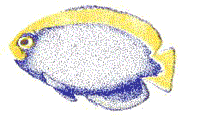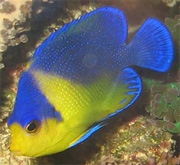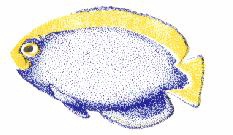|
THE REEF AT NIGHT
By Jim Wolf, Marine Biologist
The colorful reef fishes so typical of a salt water aquarium are just
a part of the reef fish community. At night, a transition occurs between
the colorful daytime inhabitants, and the dark, red colored night time
fishes. There are many familiar fishes in this group and almost all fishes are active during twilight (dusk or dawn). Groupers, lionfish,
eels and many predatory species exhibit some level of night activities
but four families are specialist in this nighttime world. They enjoy tanks
with subdued lighting, or perhaps a cave to escape the light. The two major
groups are the Cardinal fishes, and the Beryciformes, so lets look at them!
BERYCIFORMES are a group of bony fishes with a well documented
fossil record and a characteristic bony plated skull. Many are lie-in-wait
predators. This means that they lie motionless waiting for prey to come
into range. Prey items include fish, crustaceans, and worms. Many of them
are yellow to red in color because these colors quickly fade to an inconspicuous
brown under conditions of low light.
Family HOLOCENTRIDAE. This is a large family including the very
hardy Squirrel and Soldier fishes. The Squirrel fishes include about 40
species of fishes that all possess a large spine on their operculum (The
plate that covers the gills), unlike their close cousins the Soldier fish
which lack this spine. Initially they are shy and reclusive, but
the soon become very active and will accept almost any food. These animals
have a large swim bladder, so are very sensitive to sounds and tapping
on the glass. As these animals live frequently in caves, it is not unusual
to see them up side down orienting to the roof of a cave. They may
occasionally push other fish around, but have a poorly equipped mouth,
so therefore do not cause much damage. Conversely they should be watch
for signs of injury if placed into a tank with aggressive fishes.
These fish should be either solitary, or placed into a tank in groups
of three or more. If two fish are placed together one will usually pick
on the other. By grouping in 1 or 3+ you avoid these problems. The
remaining three families share this "1 or 3+ rule".
Family MONCENTRIDIDAE. This family includes only two species
of Pinecone fish. These exotic expensive specimen fish are in the realm
of the specialists fish. Pinecone fish have a bioluminescent organ under
their eye that they use to signal one another. To thrive they need a tall
aquarium with subdued lighting and tranquil tankmates. They eat live fishes
and shrimp at first and can be trained to eat prepared foods. Despite these
demands, they are well worth the effort, for how many other fishes glow
in the dark?
Family OREOSOMATIDAE. Flattened, brick metallic red, big eyes
and a large low slung mouth, the "Ox-eyed Oreos" leave a lasting impression.
Rarely seen, but non the less very impressive, they are well worth the
effort. Their care is similar to Pinecone Fish and tend to be a little
more tolerant of light and tankmates.
Family APOGONIDAE: Cardinal fishes are in many respects the damsel
fishes of the night. Members of the family Apogonidae, they fill many of
the ecological niches that are filled by the damsels during daylight on
the reef. The night time has caused them to be less territorial (since
there is less competition) and they have larger mouths ( to consume
the larger plankton associated with night time on the reef) and posses
large eyes.
They do well in small groups and are non aggressive. They eat a variety
of food and will adapt readily to captivity if they are not harassed by
other fishes. They like subdued lighting and are a good addition to a "twilight
aquarium".
There over 170 species but only a few are seen in the hobby. Sphaeramia
nematoptera is the common clown cardinal. It is tempting to add these fish
to community aquarium , however they need a tranquil environment that is
associate with either a reef or twilight aquarium. In captivity, if well
cared for, Cardinal fish will breed. The male will hold the eggs in his
mouth. On the reef they may be commensal ( to hang around with no "cost"
to either host or visitor) with sea urchins or anemones and many other
species are red to yellow in coloration with striking patterns.
|











